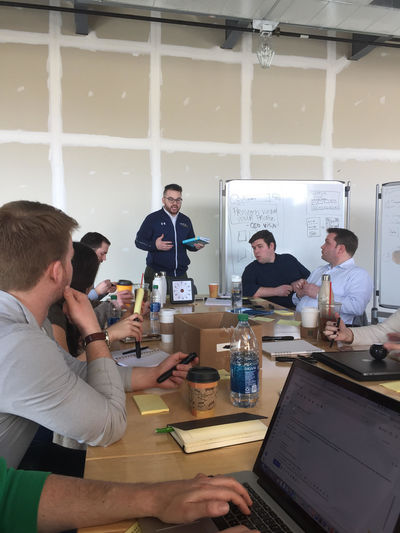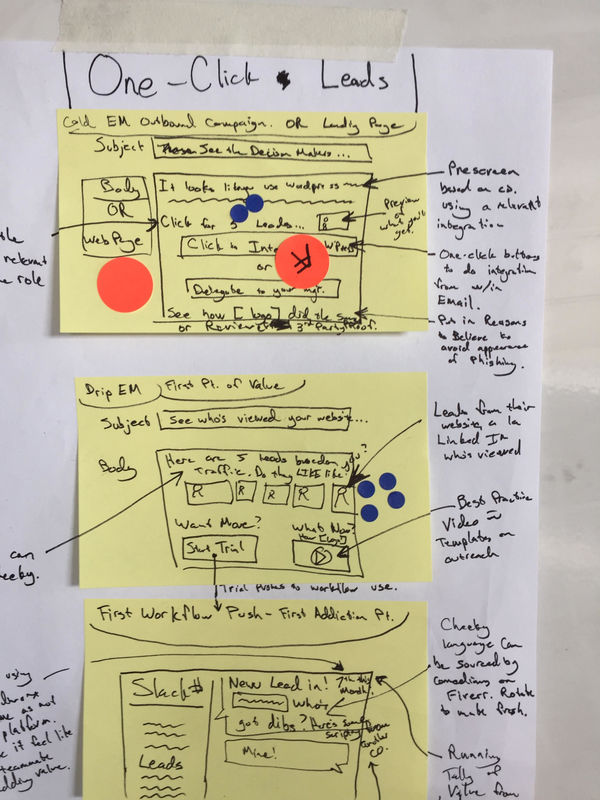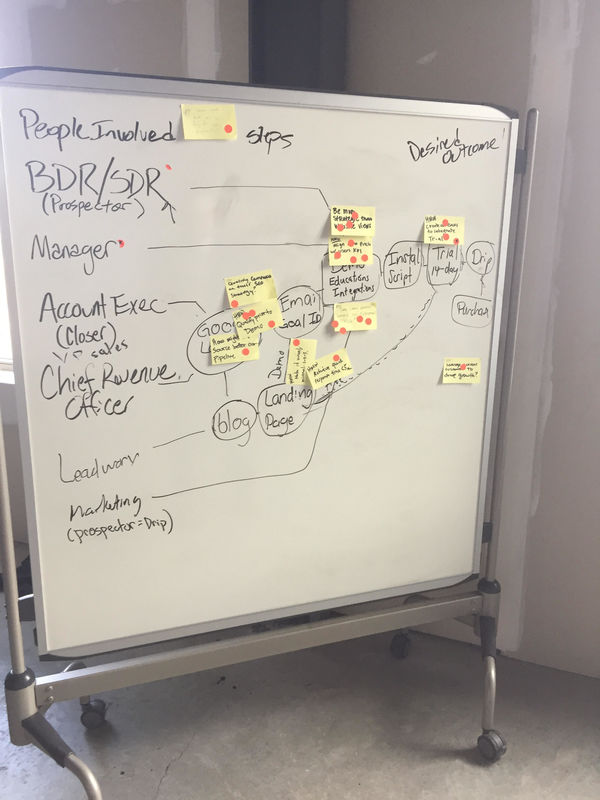
Earlier this month Leadworx participated in a design sprint facilitated by the IDEA Center.
The design sprint is a unique 5-day problem-solving process intended to answer critical business questions following the principles of design thinking.
In short, a sprint allows companies to answer questions through co creation, rapid prototyping and user testing.
During this sprint I had the pleasure of working with 7 Mendoza MBA students from different professional backgrounds. By having all these bright minds working together for 5 days I was sure we were going to come up with an amazing final product.
This is the story of how we got from a question to a validated prototype in 5 days.
Day 1 - Understanding the Problem

On the first day of the sprint I was extremely excited to be working with such a great team. I started by setting up the sprint room with white boards, post its, sharpies and snacks.
After introductions, I gave a detailed presentation on how the Leadworx platform works. The team then spent time asking me questions about Leadworx, its market, competitors, my vision for the company etc. I was basically grilled on everything Leadworx related.
Following the detailed design sprint framework, we started at the end and agreed on what problem or challenge we were going to solve this week.
As the decider, I voted we should focus on developing an automated onboarding and customer acquisition journey.
Once we had our North Star it was time to ask the experts.
The previous week I had scheduled calls with Business Development Reps (BDRs) and Account Executives at B2B companies. These end users would serve as our experts.
During the calls we were focused on understanding our persona’s unique pain points while mapping out the customer journey to create an empathy map. This technique is very useful to better understand users and prioritize their needs.
By knowing we were building a solution to address our user’s pain points, we were extremely motivated to ensure the success of this sprint.
Lesson of the day: Conducting customer interviews is the most effective method to prove or disprove longstanding assumptions a company might have.
Day 2- Sketching the Solution
We started the 2nd day with “Lighting Demos” or evaluating ideas from other competitors. We then sketched what we liked on post it notes and posted them on whiteboards around the room.
The idea behind the concept is that most innovations are a remix of old ideas.
After lunch we spend the next hour sketching rough ideas of solutions based on our thoughts and what we learned by evaluating competitors.
According to Google Ventures, brainstorming as a group is not the most effective way to transmit ideas. Instead, GV recommend each member of the team works alone to sketch his or her own ideas.
GV stresses that every IDEA should be sketched. The reason being, if something is not on paper its hard to communicate it to others.
The final task involved having each participant draw a detailed end to end solution for the problem in under 40 minutes. We were now ready to showcase our ideas the next day.
I was amazed at the quality of sketches I saw. Participants approached the challenge from a variety of angles, and that alone was worth the whole week.
Lesson of the Day: Working with individuals from various disciplines is the best way to find novel solutions to difficult problems.
Day 3- Evaluating and Choosing Ideas
As the decider, my job was to decide what sketch the team would be prototyping and showcasing to users come Friday.
All team members casted a vote, but ultimately the choice was mine. With so many amazing sketches it was not an easy choice.
After some deliberation I decided to prototype an onboarding funnel starting from the point someone visits the Leadworx site all the way to the “aha moment” when users start using Leadworx to generate more leads.
The prototype covers all of the sales funnel from awareness to loyalty.
After deciding what to prototype, off to the races we went!
Lesson of the day: People can approach a problem from various angles, but at the end if you are in the trenches every day, you will have more contextual knowledge.
Day 4- Brining the Prototype to Life
To get everything done on time we had to divide and conquer.
Part of the team worked on designing the prototype, another group wrote the copy while others worked on putting it all together and scheduling calls with users to test the prototype.
The final product was a series of screenshots and mockups that users can interact with via Zoom meeting.
Thursday was the best day for me! Spending time with all the groups I filled 4 pages with notes of actionable items I could take to make the Leadworx website more user friendly.

Day 5- Putting it All Together
It’s hard to believe that in 4 days we defined a problem, created various solutions and built a realistic prototype. It was now time to put our prototype to work.
The day consisted of talking to 5 of our buyer personas that had not heard about Leadworx.
Michael and John, the two IDEA Center facilitators did an amazing job at asking the right probing questions while I watched how users interacted with and reacted to the prototype. All in real time!
As a natural-born salesperson, I had to abstain myself from jumping in and selling during the calls. Instead, I took the backseat while I listened and observed how users interacted with the product.
The feedback from these calls was extremely valuable.
Final Thoughts.
My goal coming into this sprint was to better understand our target buyers and find ways to deliver more value to them.
I could not have been happier with the results. Working with a group of bright MBA students, developing a prototype and getting user feedback exceeded my expectations.
As the person in charge of product at Leadworx I would not mind running a design sprint at least once a quarter.
Design Sprint Resources
The official Google Ventures Design Sprint Book